GP54
| Location: Bass | Property: Recreation Reserve |
| Aust. Soil Class.: Eutrophic, Mottled-Subnatric, Brown SODOSOL | General Landscape Description: Flat of an old flood plain (0-1% slope). |
| Geology: Quaternary. |
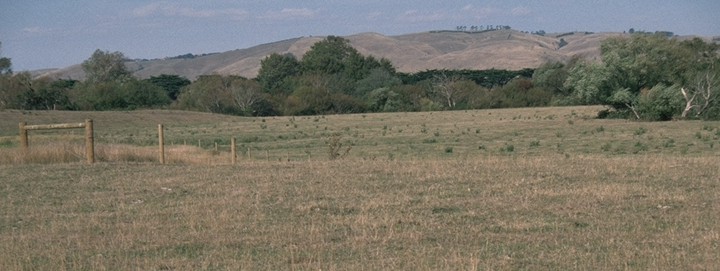
GP54 Landscape
Soil Profile Morphology:
Surface Soil
| A1 | 0-35 cm | Very dark greyish brown (10YR3/2) with occasional slight mottles; fine sandy clay loam; hardsetting surface condition; moderate fine polyhedral structure within the root zone and massive structure where there are no roots; very firm consistence dry; pH 5.4; clear and wavy change to: NOTE: there is a possible sporadic bleach. | 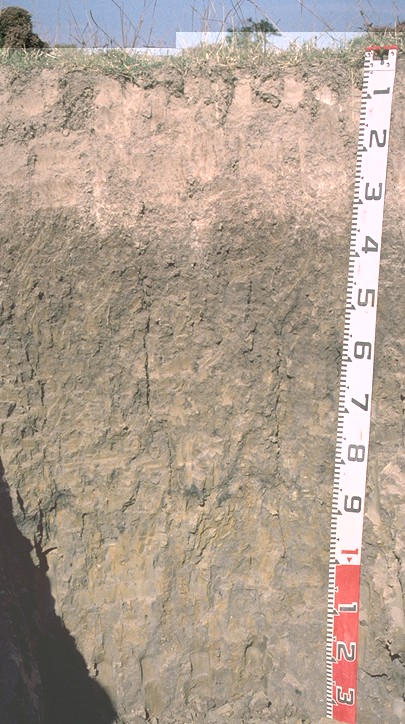 GP54 Profile |
| Subsoil | |||
| B21 | 35-60 cm | Dark brown (10YR3/3) with few (10%) yellowish brown (10YR5/6) mottles; light medium clay; moderate coarse prismatic, parting to moderate coarse polyhedral structure; strong consistence dry; pH 5.8; gradual and wavy change to: | |
| 2B21 | 60-90 cm | Grey (10YR5/1) with many (25%) brownish yellow (10YR6/6) mottles; light medium clay; moderate coarse prismatic structure; strong consistence dry; pH 6.4: | |
| 2B22 | 90+ cm | Grey (10YR5/1) with many (25-30%) brownish yellow (10YR6/8) mottles; medium clay; moderate coarse prismatic, parting to moderate coarse blocky structure; strong consistence dry; pH 6.0. |
Key Profile Features:
- Hardsetting surface condition.
- Possible sporadic bleaching within the subsurface (A2) horizon.
pH | Salinity Rating | |||
Surface (A1 horizon) | Strongly Acid | Very Low | Non-Sodic | None1 |
Subsoil (B21 horizon) | Moderately Acid | Very Low | Sodic | None1 |
Deeper subsoil (at 1 m) | Moderately Acid | Low | Sodic | None1 |
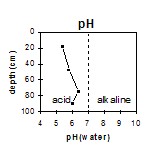 The surface soil is strongly acid. The subsoil is moderately acid. | 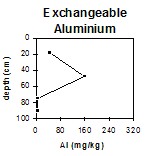 The exchangeable aluminium levels in the surface is low. But the levels within the upper subsoil (B21) are very high. | 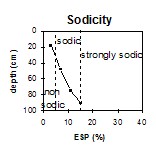 The surface soil is non-sodic. The subsoil is sodic throughout. | 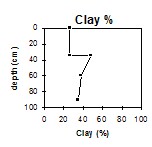 The clay content increases clearly at the A/B boundary. |
Management Considerations:
Surface (A) Horizon
- The surface soil is hardsetting and requires organic matter for maintaining soil aggregation. Currently, organic matter levels are moderate but this will decline if cropping takes place and can be improved by adopting practices such as residue retention, minimum tillage and utilising pasture rotations. Interestingly, roots were only observed within the structured soil.
- Within the strongly acid surface (A1) horizon, the level of exchangeable aluminium are not high (45 mg/kg). These levels are unlikely to effect plant growth. A pH/aluminium test on a bulked sample (from across the paddock) would be most appropriate to determine if lime is needed to raise soil pH.
- The inherent fertility of the surface (A1) horizon (based on the sum of the exchangeable calcium, magnesium and potassium cations) is low. The nitrogen levels are moderate. Planting legumes may help to alleviate the fertility deficiency.
- The surface (A1) horizon is non-sodic but disperses slightly after remoulding. This indicates that tillage or over-stocking of the soil whilst in a moist to wet condition may result in structural degradation (e.g. surface sealing, increased cloddiness) occurring. Raindrop action on bare soil may have a similar effect, so it is important to maintain surface cover. Gypsum application may assist in improving surface soil structural condition on such soils.
- The possible sporadic bleaching and slight mottling, indicates that periodic waterlogging occurs above the more slowly permeable subsoil.
- The dense and coarsely structured upper subsoil (B21) horizon is sodic and has a low exchangeable calcium to magnesium ratio (0.4). However, slight dispersion only occurs after remoulding. The high levels of exchangeable aluminium (160 mg/kg) in the upper subsoil may be the cause of the restricted dispersion. The subsoil is coarsely structured which will also restrict root movement down the profile. Interestingly, a greater amount of roots were observed where there was greater structure.
- The subsoil has a moderate inherent fertility throughout (based on the sum of the exchangeable basic cations).


